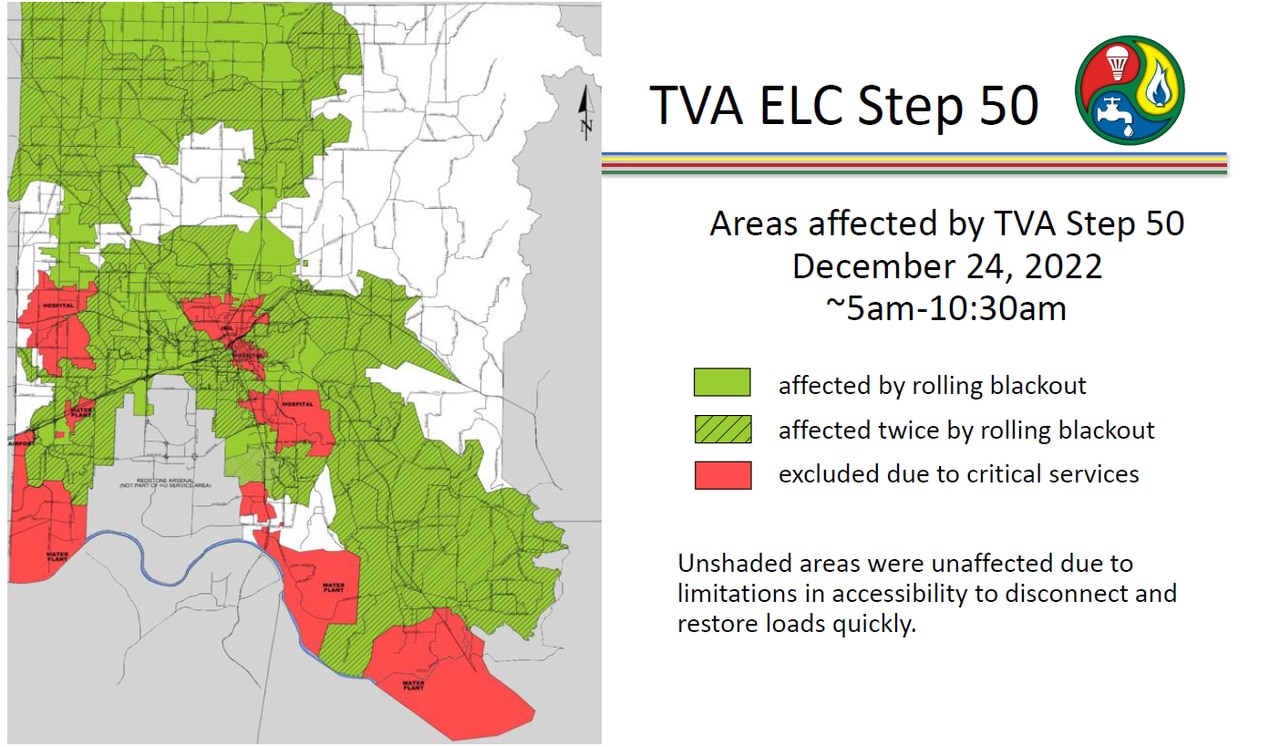Rolling blackouts ‘worked as intended,’ Huntsville Utilities says
About 60% of Huntsville Utilities electric customers were affected by rolling blackouts on Christmas Eve, CEO and President Wes Kelley said Thursday night.
Kelley addressed the city council to report on how the utility handled the record demand on its power system when wind-chill temperatures dropped below zero degrees.
The affected customers totaled about 127,000 of the utility’s 210,000 electric customers, Kelley said.
It was the first time in Huntsville Utilities’ history that it resorted to rolling blackouts that came at the behest of Tennessee Valley Authority to protect the electrical grid from overloading and shutting down as customers cranked up the heat to combat the dangerously cold weather.
Kelley said Huntsville Utilities had no choice but to implement the rolling blackouts after TVA put out the call for load reduction.
“All of the utilities in the Tennessee Valley are bound by the emergency load curtailment plan,” Kelley told the city council.
While the rolling blackouts are not an ideal solution to fending off a potential grid overload, the strategy was effective. The blackouts are what’s known as Step 50 in the emergency load curtailment plan – the next to highest step. In that case, Step 60, where TVA “just starts shutting stuff off,” Kelley said.
“We did not get to that,” he said. “And that is to avoid a worst-case scenario, which happen past Step 60, where TVA loses control of the grid and it just starts shutting itself off. So all of this is actually a sign of success. The system worked as intended but it is a blunt tool.”
Most of the affected Huntsville Utilities customers endured two blackouts that lasted about 30 minutes each, Kelley said, though some customer experienced only five-minute interruption. The blackouts occurred between 5 a.m. and 10:30 a.m., Kelley said.
Kelley said some service areas were not part of the blackouts because of their proximity to critical infrastructure, such as hospitals, water treatment plans, Madison County Jail and air traffic control facilities.
Huntsville Utilities had record electricity demands on the mornings of both Dec. 23 and Dec. 24, Kelley said. System-wide, TVA said it supplied more power on Dec. 23 than at any other time in its 90-year history.
Kelley said the rolling blackouts were the solution to a sort of rolling scenarios that left TVA without enough electricity. The blackouts were done to “address a TVA issue, not a Huntsville Utilities issue.”
“TVA had a problem with one of their large power plants,” Kelley said. “And then when they went to get other generation to meet that need within the Valley, a lot of those resources were not available, not functioning. (TVA) was bringing power in from outside the Valley that helped them get through much of this rise (of demand). And then later in the morning when the load started to fall is when they had a problem. Why was that? Well, because as the weather events spread east, it impacted power systems outside of TVA power systems that TVA was importing power from.
“When the weather got to them, they stopped that transmission of power to TVA. (It’s) completely normal, this is not a disastrous thing. And then TVA was short, and so thus the need to implement interruptions. So again, they had a loss of a power plant – understandable, that happens. Some generation wasn’t available and then the importing of power was constrained due to transmission operations.”
TVA on Dec. 28 issued a statement taking “full responsibility” for the need for rolling blackouts. The federally-owned utility said it is reviewing the situation. TVA said Cumberland Fossil Plant – about 60 miles northwest of Nashville — went offline in the wee hours of Dec. 23 due to the extreme cold and winds.
Hours later, TVA called for rolling blackouts to reduce electrical demand by 5% across the system but Kelley said Huntsville Utilities did not take part that day.
“At the time, Huntsville Utilities was still responding to a number of power outages across our area and getting local load balance issues in hand,” he said. “And then by the time those issues were resolved, our load had already dropped fairly significantly. And so at that time, we opted to use our voltage reduction program, which helps us reduce load by usually around 2-3%. And then we also work with our industrial and commercial customers to shut down to also further reduce the load. So that is how we responded on (Dec. 23).”
Like TVA, Kelley said Huntsville Utilities is doing a review to learn from what has been described as a once-in-a-generation weather event. And as far as rolling blackouts, the first time in TVA’s history. Kelley said Huntsville Utilities was, in the event rolling blackouts were needed, primed for a 20% reduction in power – not the 5-10% TVA called for.
“We had to recalculate the plan on the fly to accommodate that,” Kelley said. “That’s one of the reasons on Friday that we were delayed in our responses because our plan was predicated on a different assumption.”
